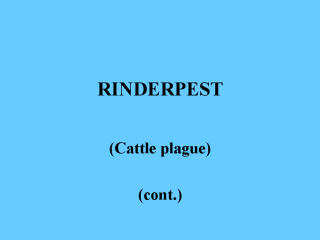| front |1 |2 |3 |4 |5 |6 |7 |8 |9 |10 |11 |12 |13 |14 |15 |16 |17 |18 |19 |20 |21 |22 |23 |review |
 |
Control: As 'cattle plague' with death from bloody diarrhoea this was a scourge throughout the world and concern by the Odiham cattle society stimulated the formation of the RVC with a french vet, whose stage name was de St Bel, as principal. This was in 1791 the year of Mozart's death. (Despite the RVC 500,000 cattle died in a subsequent epidemic in 1865 in the UK). Slaughter and restriction of movement policies eradicated the disease from Europe. It was introduced to Africa in the Boer war and is now endemic in their wildlife. It remained a major problem until the development of the 'Plowright' vaccine in Kenya in the 60's. This is a freeze-dried live vaccine which has been attenuated by repeated passage in calf kidney cells. For this Professor Plowright FRS, an RVC graduate, was awarded the very prestigious World Food Prize in 1999 re the adage 'When cattle die, people die'. He worked at the RVC for a few years before and after his time in Kenya and wrote the first version of these virology lectures in the mid-70's. In 1994, Shangri-La, outbreaks with acute enteritis and deaths were not reported as RV by vets who gave fluid therapy etc for 5 months. Disease spread when villagers cut up infected meat and milked cows with bloody-hands. In some Indian schemes vets are rewarded for reporting rinderpest. |